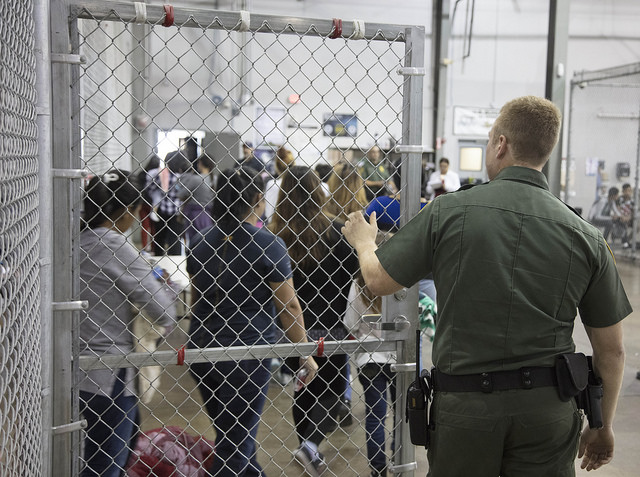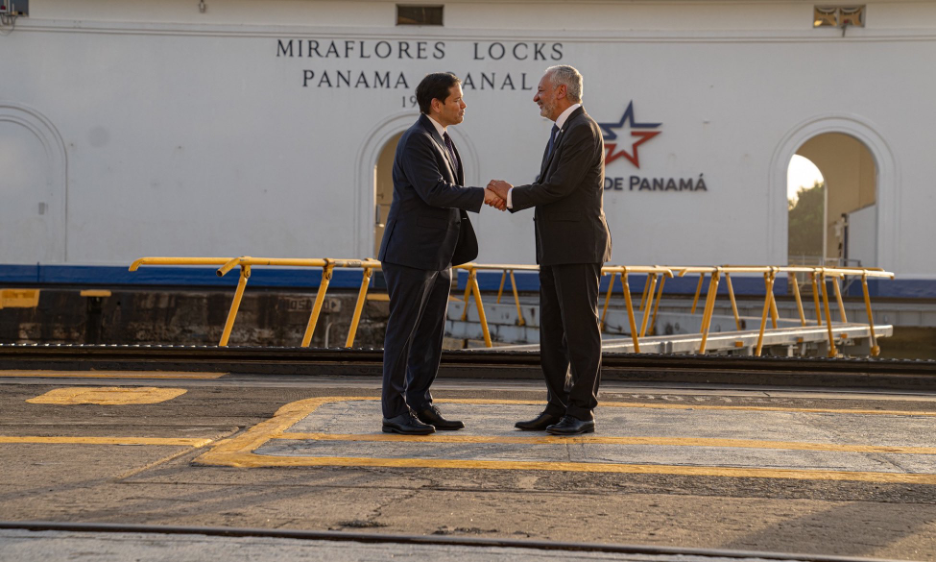From the Travel Ban to Family Separations: Malevolence, Incompetence, Carelessness
As the chaos unspooled from President Trump’s executive order on family separations, a conventional wisdom quickly emerged: This order was an echo of the very first executive order of Trump’s presidency—the travel ban.

Published by The Lawfare Institute
in Cooperation With

As the chaos unspooled from President Trump’s executive order on family separations, a conventional wisdom quickly emerged: This order was an echo of the very first executive order of Trump’s presidency—the travel ban. “The pressure Trump faced as he signed the order resembled the global reaction last year to his travel ban targeting several Muslim-majority countries,” wrote the Washington Post. “[A]s with the case of the travel ban,” the New York Times reported, “the reality of a vastly complicated bureaucratic system is colliding head-on with Mr. Trump’s shoot-from-the-hip use of executive power.” And one of us (Cordero) noted the comparison as well: Even before the order was issued, the policy echoed the first travel ban, a “campaign promise transformed into a sloppily drafted executive order from the White House, the implementation of which caused chaos at the borders.”
But while the travel ban executive order was issued on the eighth day of Trump’s presidency, the family separation policy—and the accompanying executive order—arrived a year and a half into his administration. If the chaos of the first travel ban could have been attributed, at least partly, to rookie error, that excuse is long gone. Writing in Lawfare about the first travel ban, our colleague Benjamin Wittes excoriated the order as an instance of “malevolence tempered by incompetence.” The family separations represent malevolence exacerbated by incompetence and carried out with, at worst, deceit; at best, obfuscation.
To be clear, we are writing only about the first travel ban—not the second or third iterations, the latter of which was upheld last week by the Supreme Court. We would argue that the ban’s final form is still morally—if not legally—tarred by its origins in the animus the president clearly displayed toward Muslims and Islam, as well as its lack of grounding in actual national security intelligence or analysis. But after an initial string of defeats in court, the administration’s revisions to the ban were far better lawyered and better coordinated than the original. The sheer incompetence and disorder of the first travel ban are specific to that iteration alone.
While litigation over the executive order on family separations continues, the separations themselves are reportedly on pause. But the parallels between the Trump administration’s first attempt at the travel ban, and the family divisions and associated hardships inflicted by the administration’s “zero tolerance” policy on illegal entry, still raise substantial questions about the Trump team’s approach to governance.
Let’s start with the similarities between the policies as a matter of substance. The first travel ban barred entry into the United States and the issuance of visas for citizens of seven majority-Muslim countries, as well as suspending refugee admissions. The executive order on family separations is a more muddled, complicated document: It resulted from political pushback against the administration’s “zero tolerance” policy of prosecuting all illegal border crossings, including those committed by asylum seekers, which functionally resulted in the separation of children from parents during criminal prosecutions. (Some immigrants who entered legally into the United States seeking asylum have also been separated from their children.) In response to public outcry, the order instead requires the secretary of homeland security to detain immigrant families together “to the extent permitted by law and subject to the availability of appropriations” and directs the Justice Department to amend the consent decree reached in Flores v. Reno, which prohibits the department from detaining children in immigration detention for more than 20 days.
Both executive orders are direct outgrowths of the president’s campaign promises to keep out foreigners—whether those foreigners might be Mexican or Central American or Muslim. Both are in response to a contrived security crisis: Despite the president’s dire warnings of MS-13 gangsters and ISIS terrorists swarming the country, less than 0.1 percent of those apprehended at the border over the past year were members of MS-13, and there is absolutely no data to suggest that travel from the seven majority-Muslim countries named in the original executive order posed a threat in the aggregate. The first travel ban was drafted by Trump policy aides Steve Bannon and Stephen Miller; Bannon has since been exiled from the White House, but news reports have identified Miller as the engineer of family separations, if not the drafter of the actual order. Notably, the Washington Post reported that the White House counsel, Don McGahn, questioned whether the order was even legal. If the travel ban became unavoidably associated with images of protesters crowding airports and weeping family members finally reunited, the visual shorthand of the family separation policy has become the photographs of crying toddlers and children in cages.
And the president himself drew a link between the travel ban and his “zero tolerance” border policy. “[W]e don’t want people coming in from the Middle East through our border using children to get through the line,” Buzzfeed reports he commented during a meeting last month with congressional leadership amid outcries over the family separations..
But there are unsettling parallels on a procedural level, too. The travel ban was drafted so sloppily that it was initially unclear whether the Office of Legal Counsel (OLC) had signed off on it at all. (At first OLC, as per its normal practice, refused to comment on whether it had signed off on the executive order; a Freedom of Information Act request later revealed that it had.) The Department of Homeland Security (DHS), tasked with carrying out the ban, had no opportunity to perform a legal review in advance. The order was drafted so poorly that it was unclear for days whether permanent resident aliens (that is, green-card holders) from the banned countries would be allowed to reenter the United States. Eventually, McGahn issued a clarifying memo.
The family separations policy and executive order showcase this same failure of legal and policy process. The initial policy implementation was harsh and chaotic enough to raise questions over whether the implications in both the domestic and international law of separating children from their families—apparently in the absence of due process—had been adequately vetted. And when it comes to the executive order itself, which mandated that families should be detained together “where appropriate and consistent with law and available resources,” Politico reports that it was “hastily written amid an escalating crisis and rushed to [Trump’s] desk.” According to the Washington Post, the order was drafted in mere “hours.” McGahn reportedly refused to endorse the document over concerns that it was inconsistent with the Flores settlement; after extensive editing, the Post writes, he concluded that the order “could be legal.” So far, reporting has not revealed whether the Office of Legal Counsel approved the order as to form and legality.
Once again, this failure of legal process went hand in hand with a failure of interagency coordination. In the case of the travel ban, DHS received its first briefing on the ban as the president was signing it, creating chaos as Customs and Border Protection (CBP) officials arrived at work with little to no instruction as to how to carry out their jobs. In the case of family separations, Homeland Security Secretary Kirstjen Nielsen initially insisted that there was no policy at all—and the lack of a formal written policy may have left officials at the border stranded with little legal guidance. That lack of workforce guidance raises serious concerns about the legality and propriety of agents and other government officials carrying out the family separation practice, possibly exposing themselves to legal risk and questions over ethical behavior. Even after the executive order was issued, DHS and the Department of Justice have often seemed at odds over how the policy was being carried out: The Justice Department initially insisted that Trump’s “zero tolerance” policy for prosecuting illegal border crossings was still in effect, while DHS told reporters that it was on hold.
Riffing on Wittes’s “malevolence tempered by incompetence” formulation, the journalist Michelle Goldberg characterized the family separations policy as an example of “Trump’s incompetence and malevolence ... not at cross-purposes” but, instead, interacting with “a multiplier effect.” We would describe this as malevolence exacerbated by incompetence: The harm is magnified rather than mitigated by the ineffectiveness of the implementation. While the initial separations appear to have been carried out efficiently, the sloppiness of the process as a whole has contributed to their brutality. In coordinating reunifications, government officials and foster families are heavily dependent on the memories of children too young to know their parents’ names or who communicate only in indigenous languages. We cannot think of a greater exhibition of government incompetence than taking a child from her parent without a plan in place to reunite them.
From what we know now, this sloppiness may also have provided leeway for cruelty. A lawsuit recently filed by parents separated from their children accuses officials of “sadistically teas[ing] and taunt[ing] parents and children with the prospect of separation,” while another plaintiff reports that an officer told her “Happy Mother’s Day” before separating her from her child. An emergency physician who deals with migrant children described in the New Yorker a child’s guardians as threatening that an eight-year-old boy “won’t be reunited with his parents unless he behaves” and that giving the boy a hug constituted “rewarding his bad behavior.” Agents who act in this manner could one day find themselves under scrutiny for violating the civil rights of children in implementing the separation policy. In this case, incompetence will not serve as an excuse; it may also mean culpability.
There are many such stories—though there are also stories of civil servants doing their best under difficult circumstances. The Times reports on employees of DHS and the Department of Health and Human Services “work[ing] at their desks late into the night in an effort to reconnect families” after the executive order was issued. And it is worth remembering that in its review of the travel-ban rollout, the Department of Homeland Security’s inspector general found CBP officers to have largely—though not entirely—behaved professionally and “humane[ly],” despite some contemporary press reports of misconduct.
Among the many civil servants placed in difficult circumstances by both executive orders were the Justice Department officials tasked with defending the orders in court. In one of the earlier lawsuits against the travel ban, attorney Michelle Bennett was grilled by Judge James Robart of the U.S. District Court for the Western District of Washington on how many foreign nationals of the seven banned countries had been arrested since 9/11: “Your honor, I don’t have that information,” she said. (The answer was zero.) Likewise, in a status conference convened in Ms. L v. ICE in response to the executive order, Justice Department lawyer Sarah Fabian came up empty when asked by U.S. District Judge Dana Sabraw whether the government planned to detain parents with children or release parents. “I don’t have anything to submit on that today,” Fabian told the judge.
The poor lawyering involved in the creation of the first travel ban set the administration up for endless rounds of litigation, ping-ponging between aggressive revisions and re-revisions of the order. The same thing may be playing out in the context of family separations: Judge Sabraw specifically noted in granting the injunction that “[g]overnment counsel explained … that there was no procedure in place for the reunification of these families.” At least eight other cases are being litigated over the policy, including the administration’s effort, mandated by executive order, to seek District Judge Dolly Gee’s assent in amending the Flores settlement to allow for extended detention of migrant children.
Almost as soon as the travel ban was issued, commentators speculated that the disastrous implementation was intentional—even the Post wrote that Steve Bannon had “used chaos to implement transformative policy.” Bannon fueled this theory, telling author Michael Wolff that his goal had been to ensure that “the snowflakes would show up at the airports and riot.” But whatever Leninist crisis Bannon thought he was engineering, the primary effect of the chaos was to deal the administration a string of bruising defeats in court in an area of law in which the executive branch is traditionally granted great deference. By issuing the ban on a Friday evening, ahead of the weekend travel rush; including permanent resident aliens and other travelers with pre-existing visas; and implementing the order immediately, Bannon instantly generated a highly sympathetic group of plaintiffs with standing to sue.
Is the chaos of the family separation policy another result of poor planning—or does it instead stem from clever planning, a crisis expertly engineered by Stephen Miller and carried out by Cabinet secretaries who either support the plan substantively or are subservient to White House aides? Although the level of confusion may be comparable, it is easier to apply the label of incompetence to the travel ban. The order was issued early on in an administration largely staffed by newcomers inexperienced in governance, and many of the agencies involved did not have White House-connected, Senate-confirmed leaders in place. But the implementation of the family separation policy has no such excuse. The policy was, according to multiple administration officials, intended to dissuade potential migrants from attempting the journey to the border. The secretary of homeland security both defended the agency’s activities while denying there even was a policy.
And the clash with the courts may be a little more deliberate this time around. From comments by Gene Hamilton, a senior aide to Attorney General Jeff Sessions, the administration seems to have engineered the conflict between the executive order and the Flores settlement to put pressure on Judge Gee to amend the settlement. (“There may be some litigation,” Trump said before signing the order.)
Writing after the first round of legal defeats on the travel ban, our colleague Jack Goldsmith speculated that “Donald Trump wants courts to strike down the Immigration Executive order”: “If Trump assumes that there will be a bad terrorist attack on his watch,” Goldsmith wrote, “blaming judges now will deflect blame and enhance his power more than usual after the next attack.” Luckily, Goldsmith’s suspicion does not seem to have panned out. But while the context is different today, the administration does seem to be putting itself in a position to blame the courts if things don’t go Trump’s way. That is, either Judge Gee will modify the settlement to allow for the extended detention of immigrant children, or she won’t, in which case the administration can claim it has been “forced” to begin separating families once again. This approach is consistent with the administration’s insistence on blaming other actors—congressional Democrats or immigrants themselves—for the separations.
It is hard to say right now to what extent the family separation policy is simply chaos and to what extent it is a clever engineering of chaos. But two things should be clear. First, whether as a matter of policy or not, chaos is being used in the service of cruelty. Second, it should be deeply troubling to those who care about good governance that, in the summer of 2018, this administration is still operating with the same level of disorganization that it was in January 2017. Perhaps the White House is getting better at turning chaos to its advantage, or perhaps not. But the fact that the president so quickly signed an order that appears to have had the effect of temporarily suspending, at least to some extent, the forceful separation of children from their parents in the immediate future illustrates that the practice of forced separation was carelessness as a matter of policy.
The alternatives are equally unsettling. Over a year into the Trump presidency, the White House either has decided that carelessness redounds to its benefit, or it refuses to invest the level of care required to coherently and legally roll out a policy in the first place. Whatever the truth turns out to be, the results are appalling.






